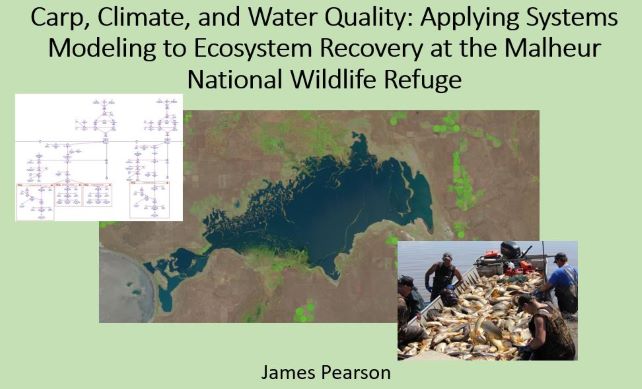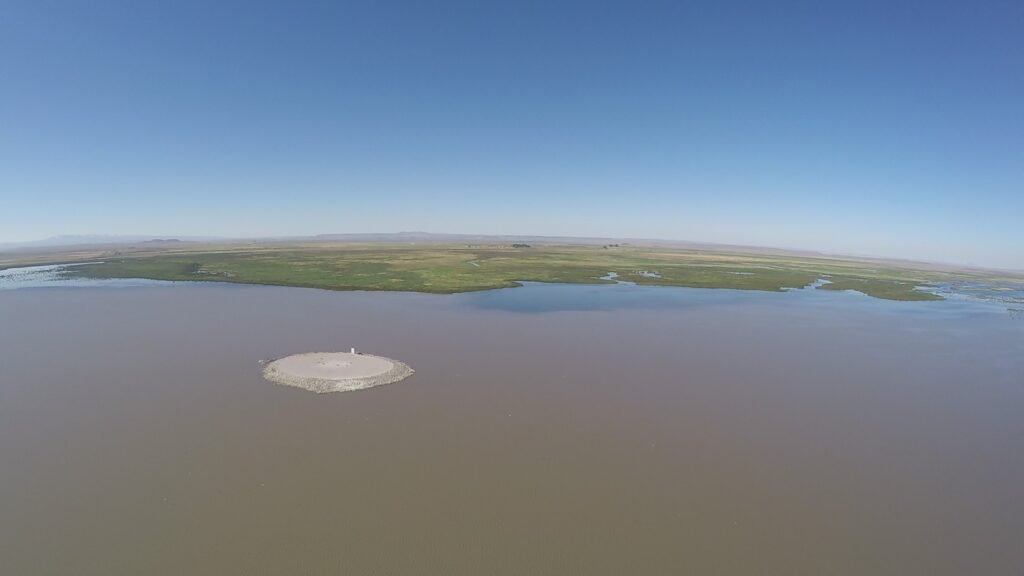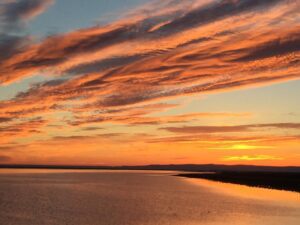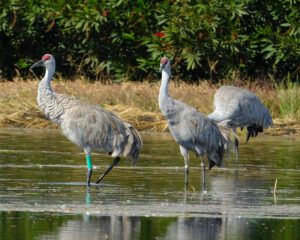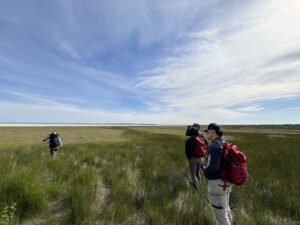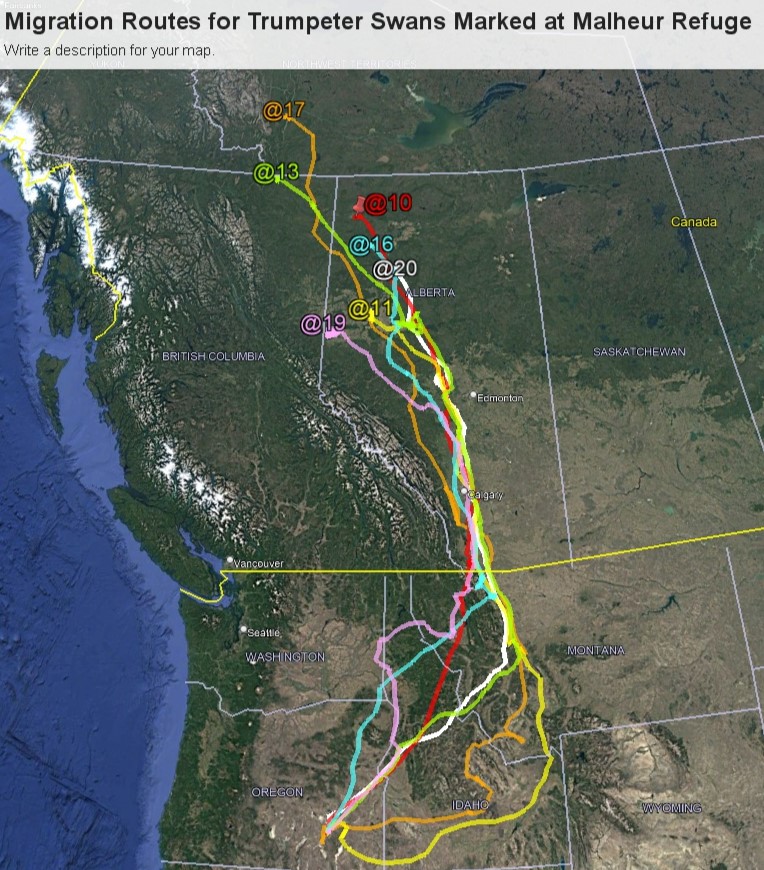Written by James Pearson/Photos provided by James Pearson
As I wrap up my Ph.D I wanted to give a brief description of my work, a quick synopsis of my results, and describe how these results have changed our thinking about restoration in Malheur Lake.
Malheur Lake is large (≈ 19,600 ha) and shallow (average depth ≈ 0.58 m; max depth ≈ 1.26 m), and therefore to better understand how Malheur Lake should function I first tried to get a basic understanding of shallow lakes in general. Shallow lakes exist in either a clear or turbid state (i.e. Alternative Stable States Theory), with the clear state characterized by an abundance of aquatic macrophytes, diverse aquatic biota, low water column nutrients and phytoplankton biomass, whereas the turbid state is characterized by the opposite. These two distinct states are maintained by reinforcing (positive) feedback loops that pull the system towards one of the two states (clear or turbid).
In order to better understand the current turbid state of Malheur Lake, I used a mechanistic modeling approach to the different factors maintaining the current state of turbidity. The two agents suspected in maintaining the turbid state in Malheur Lake are: 1) benthic (bottom) foraging by non-native Common carp (Cyprinus carpio) and 2) wind resuspension of lake-bed sediments.
I first simulated the non-native Common carp (hereafter “carp”) population in Malheur Lake and focused on controlling carp via removal efforts aimed at suppressing carp biomass below the desired 50 kg/ha threshold. These simulations indicated that individual carp removal actions would likely fail due to compensatory density dependent responses (recruitment, mortality, growth) within the carp population. Simulations further demonstrated that combinations of two or all three active removal methods could reduce the biomass below the desired threshold, however the carp reduction rate would have to be maintained ≈40% at each life-stage, in perpetuity. Furthermore, adding hydrologic variability into the carp population model ultimately demonstrated that the carp population in Malheur Lake is more affected by the interactions within the population brought on by environmental fluctuations (lake area) than the human capacity to impose mortality rates via removal efforts.
Ultimately these results demonstrated that focusing management actions solely on the reduction of carp would likely be ineffective, and thus investigations of other mechanisms helping to maintain the turbid state was necessary. Therefore, I shifted the modeling to investigate the deleterious effects of the wind and wave energy, with simulations ultimately demonstrating that the wind-wave energy is a major driver of the turbid state, and that restoration efforts in the form of wave reduction barriers may be used to decrease the suspended sediment concentrations and increase the water clarity. Collectively, modeling results reinforce the notion that future restoration actions in Malheur Lake must be more broadly focused (i.e. systems perspective) and guided by the principles of the alternative stable state theory.
Whereas our modeling demonstrated that human-constructed wave reduction barriers may be used to decrease the overall SSC in Malheur Lake, there are other means of attaining the same ends. For instance, facilitating the establishment of emergent vegetation in the lake could reduce wind-driven SSC, with results expected to vary among locations based on results of this work. Work in other systems has demonstrated that emergent vegetation can act to dissipate wave energy in shallow lakes, thus decreasing the winds forces and limiting resuspension. The rigid stems of emergent vegetation can dissipate the height of peak turbulence, and thus lower the frequency of resuspension events (increased wave dissipation with stem density). Furthermore, I was unable to find a study that has demonstrated deleterious effects of carp on emergent vegetation, yet there are a large number of studies demonstrating the negative effect of carp on submergent vegetation both directly and indirectly. Therefore, unlike submergent vegetation that is adversely affected by carp, emergent vegetation should be able to persist even in the presence of carp, and thus provide shelter from the forces of wind and potentially promote favorable growing conditions for submergent vegetation during years in which the carp biomass is low either via carp management actions or natural population fluctuations brought on by environmental variability.
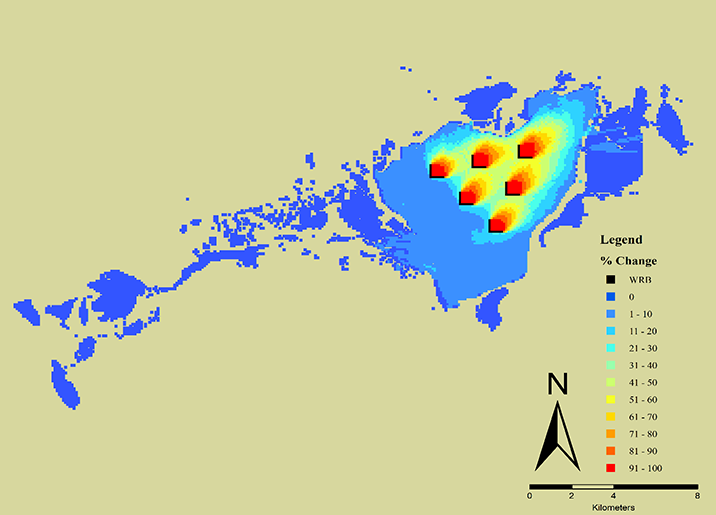
The potential ability for emergent vegetation to diminish the deleterious effects of wind-wave energy, and the fact that emergent vegetation is seemingly not effected by the presence of carp, led me to consider why there is currently very little emergent vegetation present in Malheur Lake. Historical documents describe how antecedent hydrological events are important in determining the contemporary lake state. For instance, during the prolonged flooding in the 1980’s, Malheur Lake increased to a lake area of ≈ 51,500 ha with a max depth of ≈ 4.4 m, exceeding all previously instrumented recordings. These floods inundated the robust emergent vegetation stands for an extended period of time and under depths at which they may not have been able to survive, and thus once the flooding subsided, Malheur Lake was void of emergent vegetation except for a narrow ring around the lake. Therefore, it has been hypothesized that the loss of emergent vegetation, specifically the rooted structures that act to secure the sediment is why Malheur Lake is now highly susceptible to wind resuspension.
To eventually overcome the momentum of the reinforcing feedback loops pulling Malheur Lake towards the turbid state, results of my research indicate that a large perturbation is needed, and the individual scenarios that I modeled will likely in themselves be ineffective at shifting the lake back to the clear state because their forces are too small in the context of Malheur Lake. Therefore, a more large-scale transformative effort that includes carp management, wind fetch reduction, and transplantation of emergent vegetation will likely be necessary to not only flip the current state, but also to maintain the clear state in perpetuity.
-

An aerial view of Tern Island on Malheur Lake -

2019 Tribal Stewards crew heading out for a days work on the Lake -

James with 2019 Tribal Stewards participants Darrell and CeCe -

James Pearson, PhD.
Malheur NWR Fisheries Biologist

